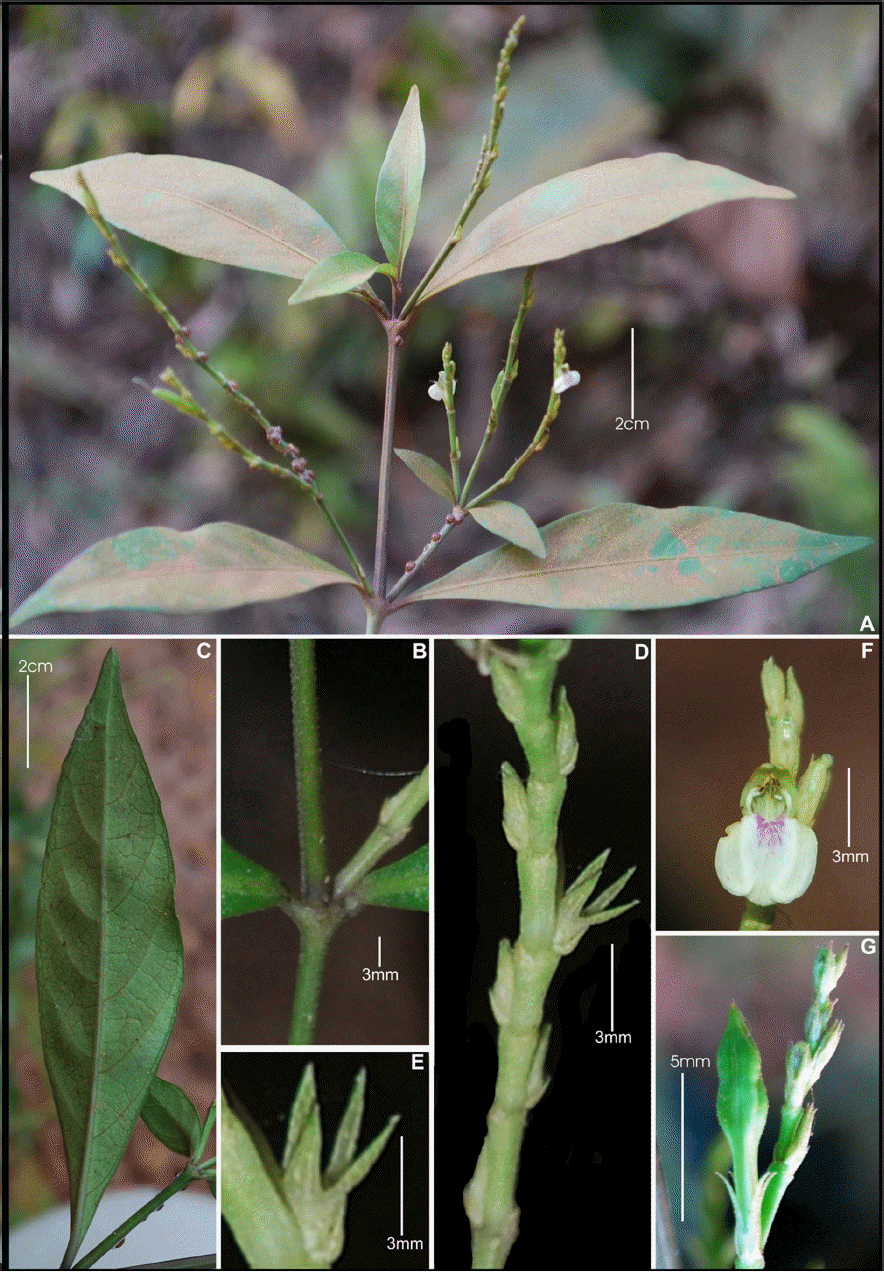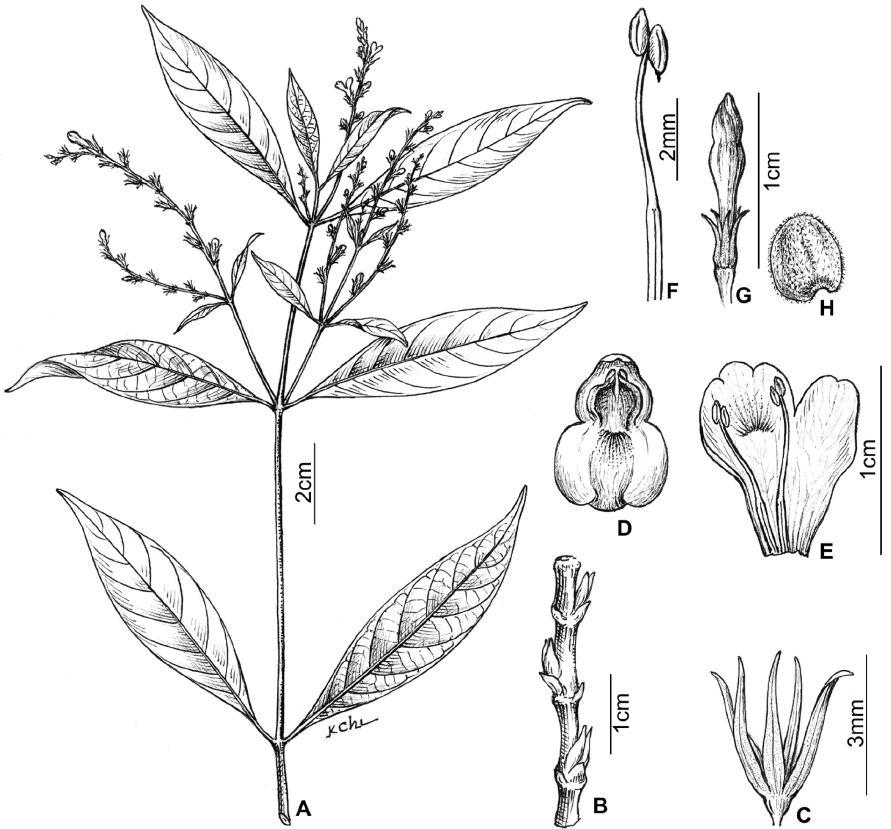적 요
Justicia kampotiana Benoist (쥐꼬리망초과)를 베트남 미기록종으로 보고한다. 본 종은 유사종인 J. ingrata Benoist와 달리 외화관에 털이있으며, 화통은 판연 보다 약간 길고 화병보다는 아주 짧다. 종 동정을 위한 기재, 그림도해 및 컬러사진과 함께 본 종과 유사종의 비교를 위한 검색형질들을 제시하였다.
Abstract
Justicia kampotiana Benoist (Acanthaceae) is reported as a new record for the flora of Vietnam. This species differs from its allied species J. ingrata Benoist in having corolla outside pubescent, tubes slightly longer than limbs and considerably shorter petioles. Description, line drawing and color photographs are provided for species identification. Furthermore, a comparison of the diagnostic characters with those of related species is made.
Phu Quoc is the largest Vietnamese island lying in the Gulf of Thailand, 45 km due west of the Vietnam mainland and 15 km south of the coast of Cambodia. Primary lowland tropical forests cover the northeast of the island, and since 1986, these unique insular forests have been protected as the Phu Quoc Nature Reserve, now a National Park, covering an area of 31,442 ha (Abramov et al., 2008). The area is known for its rich vegetation having 1,164 spermatophytes belonging to 137 families and 531 genera (Anonymous, 2006). Major vegetation types of the national park include mangrove forests, Melaleuca forests, palm bushlands, coastal dry forests, open Dipterocarp forest, Imperata grassland and forests on the stony hills and mountains.
Justicia L., the largest genus in the family Acanthaceae with about 600 species, is distributed throughout the tropics and subtropics of both hemispheres (Graham, 1988; Mabberley, 2008; Hu et al., 2011). The genus is characterized by its herbaceous or shrubby perennial habit, simple spike, or compound with dichasial or spicate inflorescence (rarely a solitary flower), 4–5 partite calyx, tubular or bilabiate corolla, 2 dithecous anthers, bilocular ovary and 4-seeded capsules. Graham (1988) recognized 16 sections in the genus, seven of which are in the Old World and nine in the New World. His circumscription was based on inflorescence type, corolla shape, anther shape, seed testa structure, and pollen morphology. Taxonomic studies on Justicia from Indochina have been carried out by many workers. Some of the important outcome resulted from the works of Benoist (1935), Ho (2000) and Lien (2005). The most recent study reports the occurrence of 33 species of Justicia in Vietnam (Lien, 2005).
During a floristic exploration trip to Phu Quoc district, Kien Giang province of Vietnam in 2010 (Fig. 1), an interesting species of Justicia was encountered and was identified as Justicia kampotiana Benoist after a thorough scrutiny of the available literature and type material (Benoist, 1936; Ho, 2000; Lien, 2005; Hu et al., 2011). In 2011 again, the plant was encountered from the other locality of Phu Quoc district growing at an elevation of 219ft. This species was so far reported from Cambodia and China but never from Vietnam. Hence, we report it as a new distributional record for the flora of Vietnam. J. kampotiana belongs to the section Rhaphidospora, which is characterized by having dichasial type inflorescence and is distributed throughout Old World, in West Tropical Africa, extending through tropical Africa to South Africa with a few species in India, Malesia, New Caledonia and Australia (Graham, 1988). Taxonomic description, details of type specimens, ecology and distribution of the mentioned species are provided with illustration.
Taxonomic descriptionTYPE: CAMBODIA: environs de Kampot, March 1914, A.J.B. Chavalier 31789 (holotype: P-Photo!).
Mananthes kampotiana (Benoist) C.Y.Wu & C.C.Hu, Fl. Reipubl. Popularis Sin. 70: 294, 2002.
Erect herbs to 1 m tall. Stems more or less quadrangular, subglabrous. Leaf blade oblanceolate to lanceolate, 5–10 × 1.5–3.5 cm, glabrous on both surfaces, secondary veins ca. 6–8 on each side of midvein, base cuneate, margin entire, apex shortly acuminate; petiole 3–6 mm long, glabrous. Spikes axillary or terminal; rachis quadrangular, subglabrous, 1-flower per node; bracts narrowly triangular, ca. 1.5 mm long, abaxially pubescent; bracteoles similar to bracts. Calyx ca. 3 mm, 5lobed almost to base; lobes linear, subequal, apex acute, outside pubescent, inside glabrous. Corolla ca. 1 cm, outside pubescent; tube slightly longer than limb; lower lip 3-lobed, lobes curved, lobes subequal, ovate, and apex rounded; upper lip subtriangular, erect, apex emarginate. Stamens 2; filaments ca. 4 mm long, glabrous; anther bithecous, superposed, above one muticous, lower one spurred at the base. Ovary with 2 ovule per locule, style glabrous, stigma slightly 2-lobed. Capsule glabrous, with a sterile basal stalk and a fertile head. Seeds compressed. Flowering and fruiting: January–May.
Distribution: Cambodia, China (Guangxi), Thailand & Vietnam (Phu Quoc District).
Ecology and habitat: The plant was found growing in coastal dry forests on rocky slopes and roadsides in association with Barringtonia, Breynia, Buchanania, Croton, Garcinia, Imperata, Rothmannia at elevations of 7-10 masl.
Specimens examined: VIETNAM. Kien Giang Province, Phu Quoc District, Phu Quoc National Park, N10°25′38″ E103°59′50″, Alt. 118ft., 15 April 2010, D.V. Hai et al. PTV 396 (HN); Phu Quoc District: Cua Duong Commune, N10°14′42″ E104°02′04″, Elev. 219 ft.,17 January, 2011, D.V. Hai et al. PTV 643 (HN). CAMBODIA: Koh Kong, S. Hul, L. Yok, S. Lim 1060 (P); Kampong Som: K.C. Cheng, S. Hul, B. David & M. Leti CL-918 (P). CHINA. Guangxi: Jingxi xian, Renzhuang Xiang, April 2005, Wei Yigang s.n. (IBSC); Napo xian, Pingmeng gongshe, Mengda dadui, Apr. 16, 1976, Fang Ding & Liu Dayu 22286 (GXMI); Daxin Xian, Xialei Nature Reserve, 320 m, Exped. Guangxi 1533 (IBK); Daxin Xian, Xialei Xiang, Xinfeng cun, near Tianjuntun, 300–650 m, 16 Oct., 2008, Exped. Guangxi 4051 (IBK); Daxin Xian, near Naling Xiang, 400 m, 15 May, 2008, Exped. Guangxi 0504 (IBK); Daxin Xian, Shuolong Zhen, Detian Cun, 23 Jun. 2008, Deng Yunfei 20635 (IBSC). THAILAND. Krabi: Ban Keng, ca. 25 m, 10 November 1930, A.F.G. Kerr 19830 (ABD). Nakhon Ratchasima: Korat, Takum, ca. 50 m, 29 December 1929, A.F.G. Kerr 17865 (ABD); Khao Yai Nat. Park, 800 m, 13 Mar., 1968, C. F. van Beasekom & C. Phengklai 16 (E, L); Khao Yai National Park, Khao Kieo, 14° 45’N, 102° E, 500–600 m, 31 Oct., 1969, C. F. van Beusekom & C. Charoenpol 1954 (L); Prachin Buri: Khao Yao, 800 m, 21 June 1963, Kai Larsen 10236 (E). Trat: Ko Kut, 13 Apr. 1951, T. Smitinand 286 (L); Ko Kut, 21 Nov., 1970, C. Charoenphol et al. 5107 (L).
Summary: Justicia kampotiana is closely related to Justcia ingrata Benoist, but can be easily distinguished from later by the presence of considerably shorter petiole, narrowly triangular and abaxially pubescent bracts, pubescent calyx (outside), corolla tube longer than lip and emarginate apex of the lip. The morphological comparison between them is shown in Table 1. Extended distribution of J. kampotiana (which is the closest ally of a Vietnamese endemic species J. ingrata) in Vietnam suggests speciation of this plant group in Indo-Chinese peninsula. Molecular phylogenetic study on these species is warranted.
ACKNOWLEDGMENTSAuthors are grateful to Mrs. Le Kim Chi for preparing the illustration. The fieldwork in Phu Quoc National Park was supported by the joint project between Institute of Ecology and Biological Resources (IEBR) and Korea Research Institute of Bioscience and Biotechnology (KRIBB). DY (4th author) thank the curator for the help rendered during his visits to the following herbaria: ABD, E, GXMI, IBK, IBSC, L and P. RKC (3rd author) acknowledges to the MoU between KRIBB and Agharkar Research Institute, India, which facilitated this research.
Fig. 2.
Justicia kampotiana Benoist. A. Flowering twig; B. Stem; C. Abaxial portion of leaf; D. Rachis; E. Calyx; F. Open flower (front view); G. Fruit and calyx (Photos by D. V. Hai) 
Fig. 3.
Justicia kampotiana Benoist. A. Flowering twig; B. Rachis; C. Calyx; D. Open flower (front view); E: Corolla (open); F. Stamen; G. Fruit and calyx; H. Seed (Illustration drawn by Mrs. Le Kim Chi, from PTV 396, HN) 
Table 1.Morphological comparison of Justicia kampotiana with its closest ally. Literature CitedAbramov, AV. Jenkins, PD. Rozhnov, VV and Kalinin, AA. 2008. Description of a new species of Crocidura (Soricomorpha: Soricidae) from the island of Phu Quoc, Vietnam. Mammalia 72: 269-272.
Anonymous. 2006. Ecotourism development strategy of the Phu Quoc National Park, Kien Giang Province. University of Agriculture and Forestry - Ho Chi Minh City 1-64.
Benoist, R. 1935. Flore Générale de l'indo-Chine 4: 728-753.
Benoist, R. 1936. Acanthacées nouvelles d'Indochine. Notulae Systematicae 5: 118-119.
Graham, VAW. 1988. Delimitation and infra-generic classification of Justicia (Acanthaceae). Kew Bulletin 43: 551-624.
Ho, PH. 2000. Cây Cỏ Việt Nam (An illustrated flora of Vietnam). 3: 75-81. Young Publishing House, Ho Chi Minh, Vietnam. (in Vietnamese).
Hu, J-Q and Daniel, TF. 2011. Justicia. Flora of China. Wu, ZY. Raven, PH. Yang, DY (eds.), 19: 461. Science Press, Beijing and Missouri Botanical Garden Press, St. Louis.
Lien, TK. 2005. Acanthaceae. Checklist of plant species of Vietnam. 3: Agricultural Publishing House, Hanoi. 251-281.
Mabberley, DJ. 2008. Mabberley's plant book: A portable dictionary of plants, their classifications, and uses. 3rd ed. Cambridge University Press, Cambridge.
|
|
||||||||||||||||||||||||||||||||||||||||||